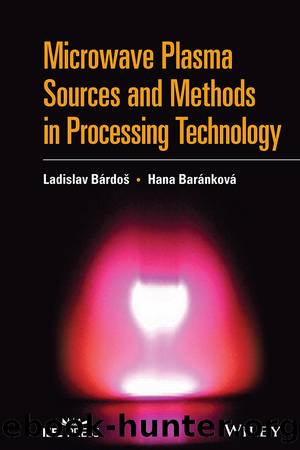Microwave Plasma Sources and Methods in Processing Technology by Ladislav Bárdoš & Hana Baránková

Author:Ladislav Bárdoš & Hana Baránková [Bárdoš, Ladislav & Baránková, Hana]
Language: eng
Format: epub
ISBN: 9781119826897
Published: 2022-01-20T10:15:38+00:00
4.1 Waveguide-Generated Isotropic and Magnetoactive Microwave Plasmas
Pioneering experiments with the microwave plasma in waveguide structures were dated by the 1960s of the twentieth century. After the Nobel Prize in Physics was awarded for research in semiconductors and discovery of the transistor in 1956, the first works were devoted to the oxidation of semiconductors in an oxygen microwave plasma to create dielectric oxides at temperatures below 500°C, see Refs. [4.1â4.3]. The discharge system was arranged with a simple discharge tube about 2 cm in diameter passing through a tapered part of the rectangular waveguide (see Figure 2.11c, Chapter 2). With selected parameters (gas pressure, position of the tube), this arrangement can work as a resonator with low reflected power. Several waveguide-based resonator cavities (see Section 1.3.5, Chapter 1) for generation of discharges were described in 1965, see Ref. [4.4]. Some of these cavities were capable of generating an atmospheric microwave plasma. More complicated microwave structures were tested with plasmas in the magnetic field, see Refs. [4.5â4.7]. Some of those will be described in Section 4.1.2. Different microwave plasma systems with details and rich lists of references can be found, see Refs. [4.8, 4.9]. The plasma generated without any auxiliary magnetic field can be considered as an isotropic plasma because no specific force affects the plasma parameters. This is contrary to an anisotropic plasma where the anisotropy is given by an auxiliary magnetic field. Such plasma can be characterized as a magnetized or magnetoactive plasma.
As explained in Chapters 2 and 3, the microwave plasmas often use auxiliary magnetic fields. The magnetic field of induction Bce = meÏ/e, where me and e are mass and charge of the electron, respectively, and Ï = 2Ïf is the frequency (called angular frequency) of the microwave generating power, allows resonant absorption of the microwave power (ECR) and much higher plasma density than the critical (cut-off) density ncrit defined in Chapter 2 in Eq. (2.10). For the microwave frequency f = 2.4 GHz, the ncrit â 7.1 1010 cmâ3 (for f = 2.35 GHz ncrit â 6.8 1010 cmâ3). In the ECR and higher induction magnetized microwave plasmas, the plasma density can reach an order of 1013 cmâ3 at several mTorr of the gas pressure. This classifies such plasmas as high-density plasmas. The presence of magnetic field means a presence of a driving force for the charged particles in the plasma, defined by the Lorentz force vector, see Eq. (3.11) in Chapter 3. In Chapter 3, gradients of the non-uniform magnetic inductions were shown to represent extra driving forces for charged particles, see Eq. (3.14) in Section 3.3.2, Chapter 3. Because of Coulomb forces acting between electrons and ions, the driving of electrons or ions means driving the whole plasma in the same direction by an effect called the ambipolar diffusion. This explains why the magnetic field must be designed and positioned carefully. Several microwave magnetoactive plasma systems used in oxidation experiments, see Refs. [4.10â4.16], are schematically illustrated in Figure 4.1.
Figure 4.1âMicrowave magnetoactive plasma systems. (a) Rectangular
Download
This site does not store any files on its server. We only index and link to content provided by other sites. Please contact the content providers to delete copyright contents if any and email us, we'll remove relevant links or contents immediately.
| Antennas | Microwaves |
| Mobile & Wireless | Networks |
| Radar | Radio |
| Remote Sensing & GIS | Satellite |
| Signal Processing | Telephone Systems |
| Television & Video |
Whiskies Galore by Ian Buxton(41888)
Introduction to Aircraft Design (Cambridge Aerospace Series) by John P. Fielding(33064)
Small Unmanned Fixed-wing Aircraft Design by Andrew J. Keane Andras Sobester James P. Scanlan & András Sóbester & James P. Scanlan(32744)
Craft Beer for the Homebrewer by Michael Agnew(18146)
Turbulence by E. J. Noyes(7943)
The Complete Stick Figure Physics Tutorials by Allen Sarah(7312)
Kaplan MCAT General Chemistry Review by Kaplan(6868)
The Thirst by Nesbo Jo(6834)
Bad Blood by John Carreyrou(6559)
Modelling of Convective Heat and Mass Transfer in Rotating Flows by Igor V. Shevchuk(6392)
Learning SQL by Alan Beaulieu(6214)
Weapons of Math Destruction by Cathy O'Neil(6152)
Man-made Catastrophes and Risk Information Concealment by Dmitry Chernov & Didier Sornette(5926)
Digital Minimalism by Cal Newport;(5670)
Life 3.0: Being Human in the Age of Artificial Intelligence by Tegmark Max(5479)
iGen by Jean M. Twenge(5368)
Secrets of Antigravity Propulsion: Tesla, UFOs, and Classified Aerospace Technology by Ph.D. Paul A. Laviolette(5311)
Design of Trajectory Optimization Approach for Space Maneuver Vehicle Skip Entry Problems by Runqi Chai & Al Savvaris & Antonios Tsourdos & Senchun Chai(5012)
Pale Blue Dot by Carl Sagan(4917)
